
SZ CHAPEL+, 2024, 200×200 cm
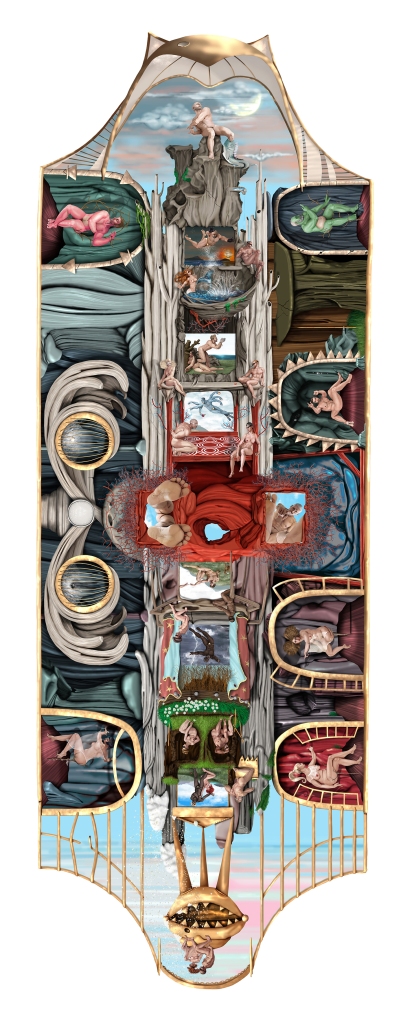

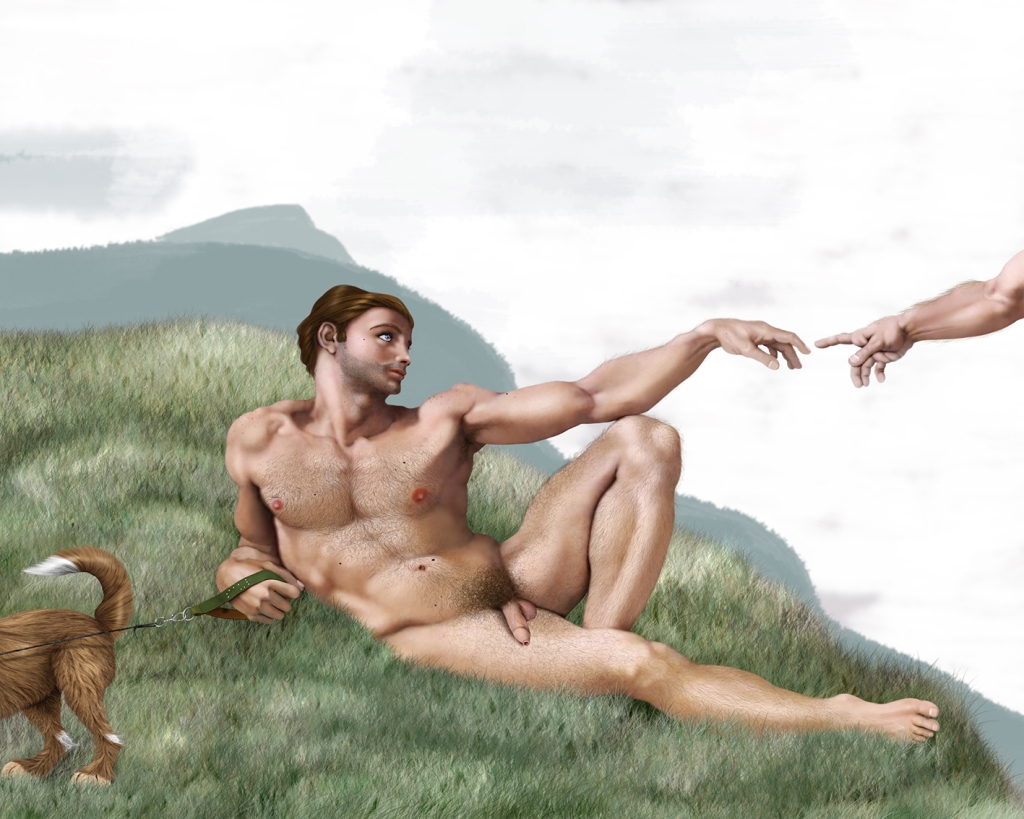






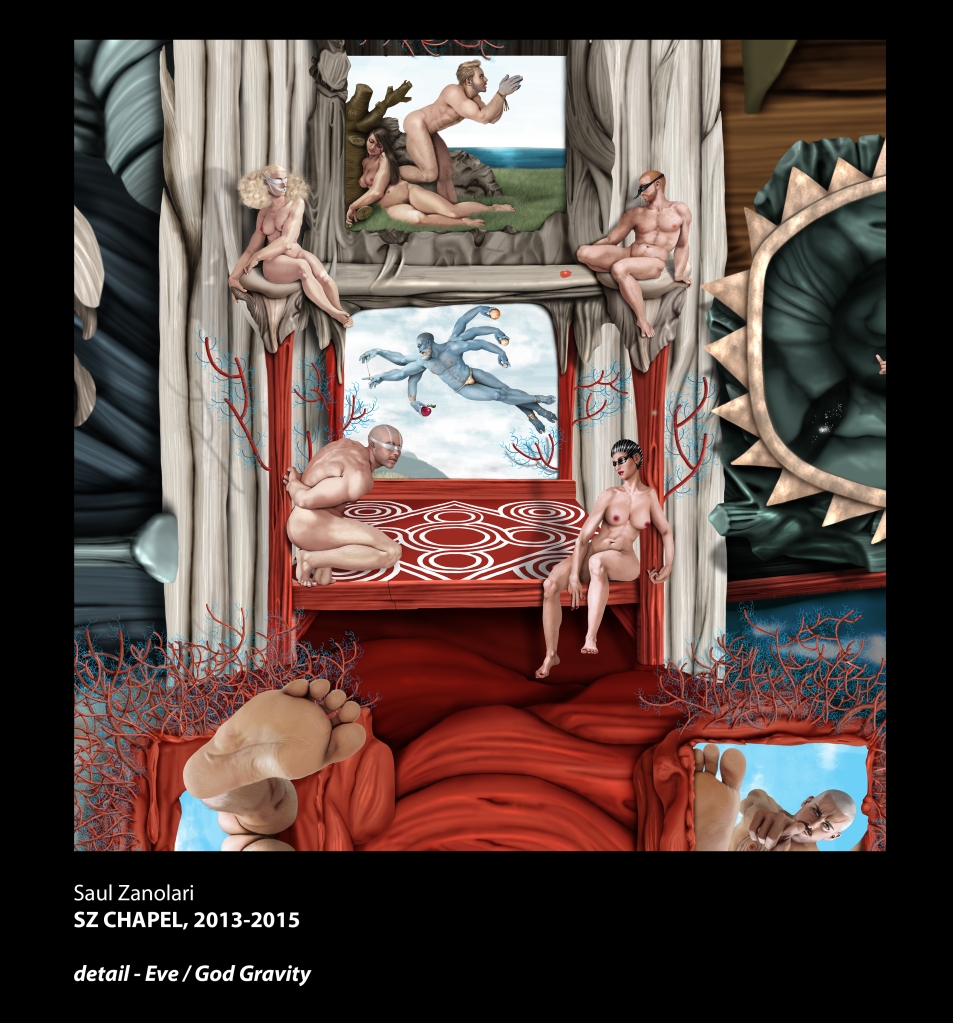


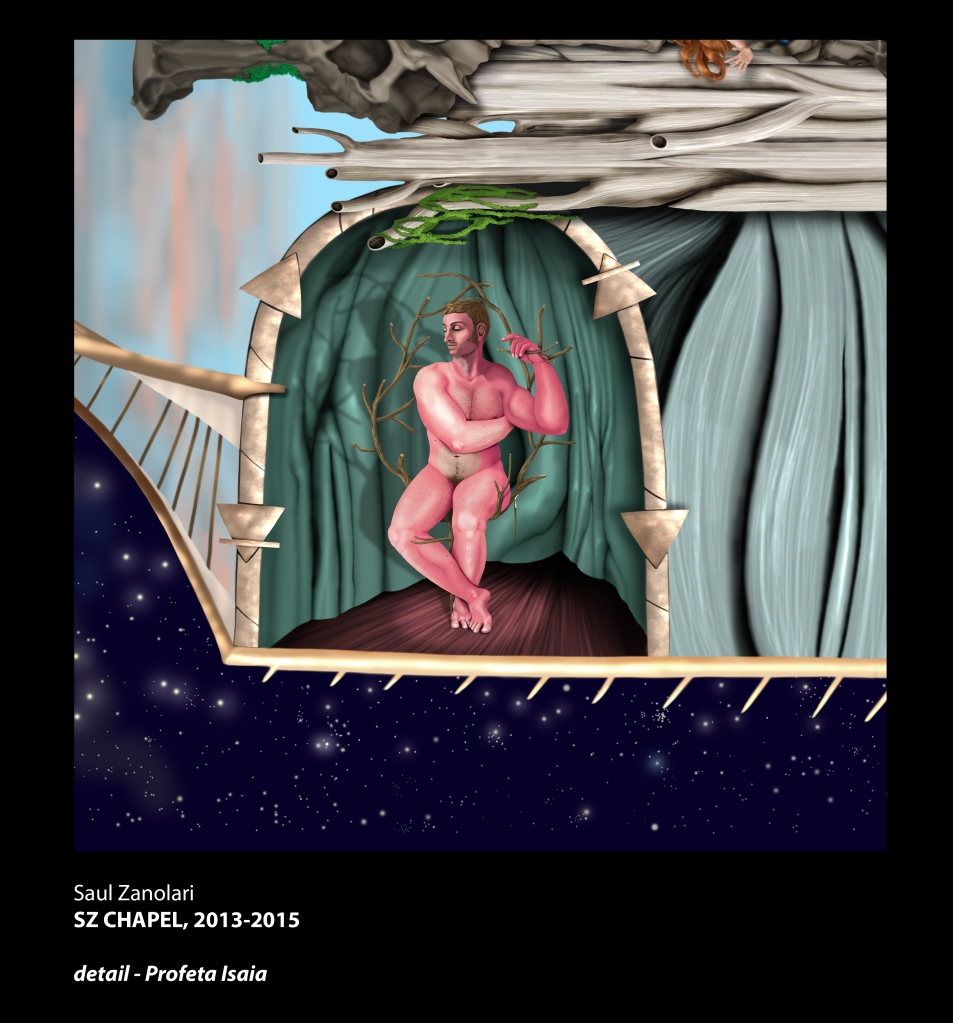



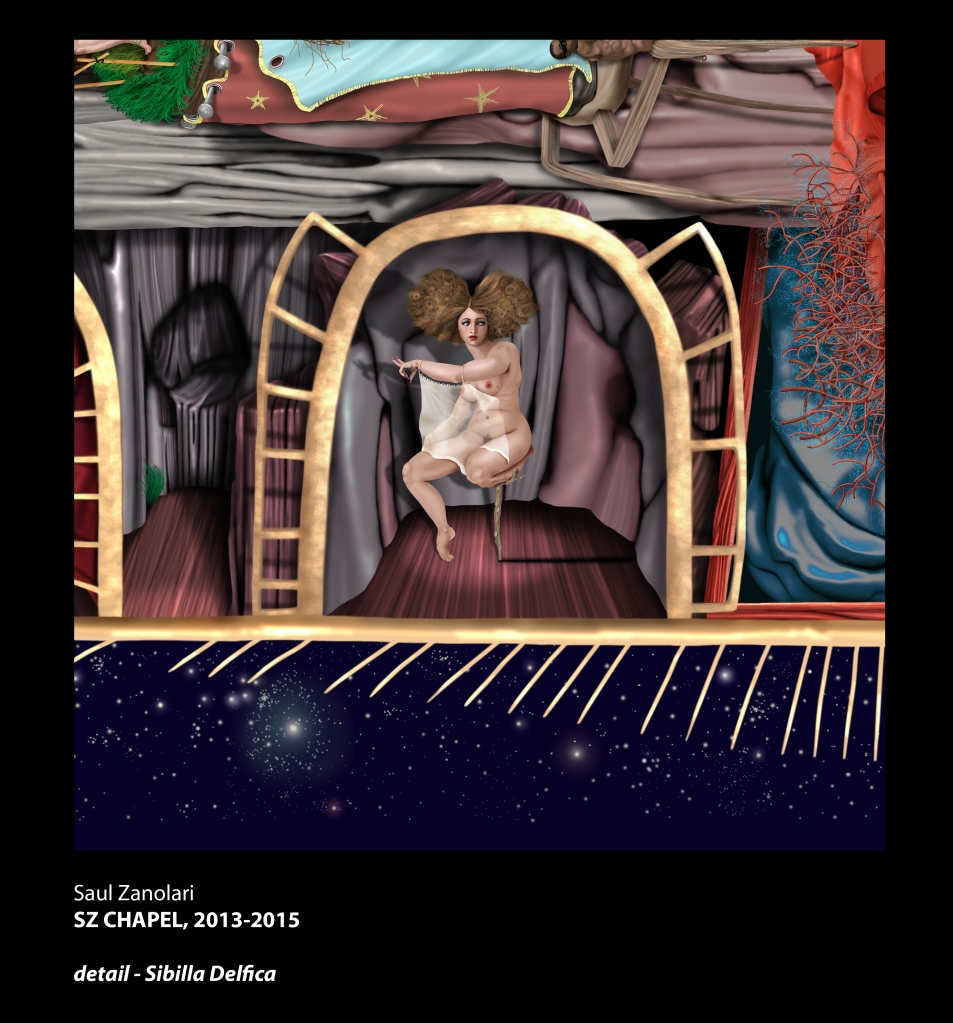

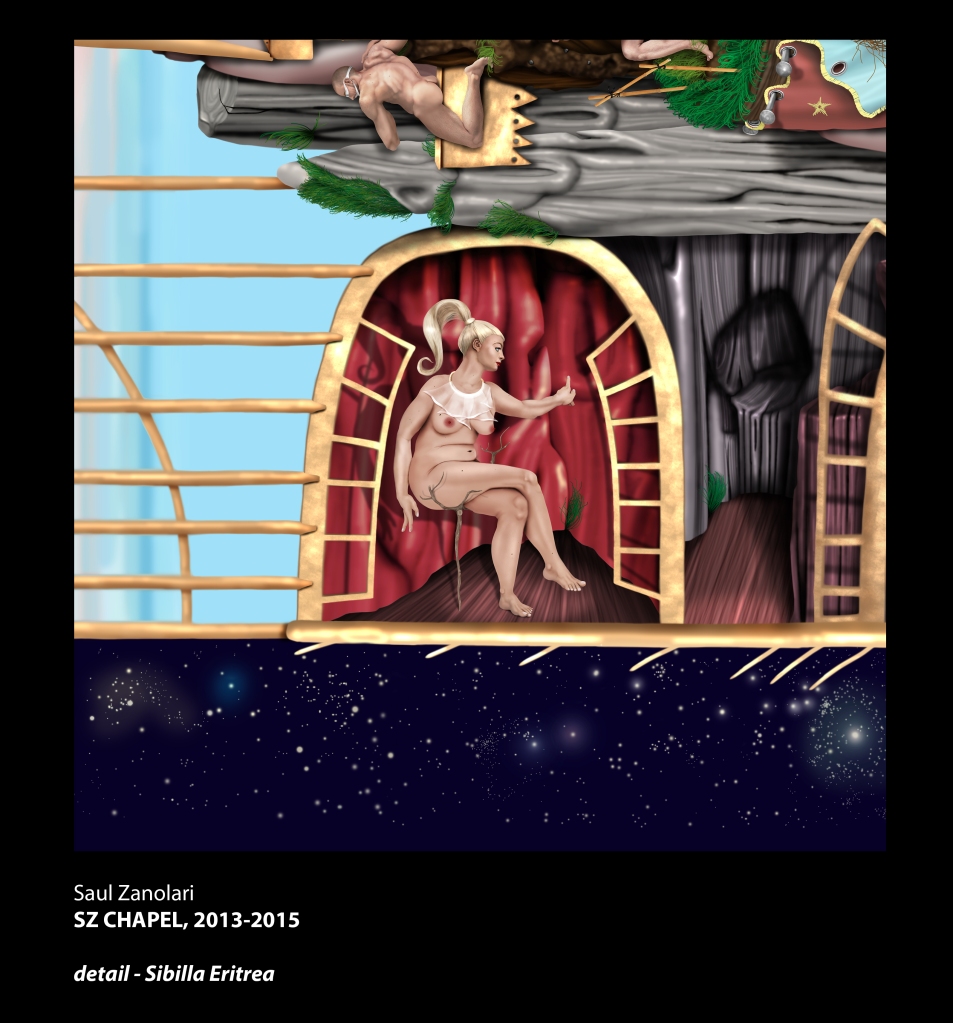



“Modesty has always been a thorny subject in art.
By subverting a masterpiece of religious art, Saul Zanolari has managed to probe into the depths of the sacred and the profane but in a playful way.
Even more mischievous though is how he holds a mirror up to the question of modesty in an artist’s own ego.”
-Diane Pernet-
PRESENTATION
SZ Chapel is a digital painting.
It measures 32×14 meters (scale 1:1 with Michelangelo’s Sistine Chapel).
The first digital brush stroke was given on March 4th 2013. The last one on May 6th 2015.
COMPOSITION
SZ Chapel is composed of
6 main paintings:
- Adam (fig. 1)
- Eve (fig. 2)
- Original Sin (fig. 3)
- God Electromagnetism (fig. 4)
- Atomic God (fig. 5)
- God Gravity (fig. 6)
- twelve Ignudi “blindly” observing the main scenes,
- three Sibyls,
- four Prophets,
- one Mermaid and
- two self-portraits
Fig. 1

Fig. 2

Fig. 3

Fig. 4

Fig. 5

Fig. 6
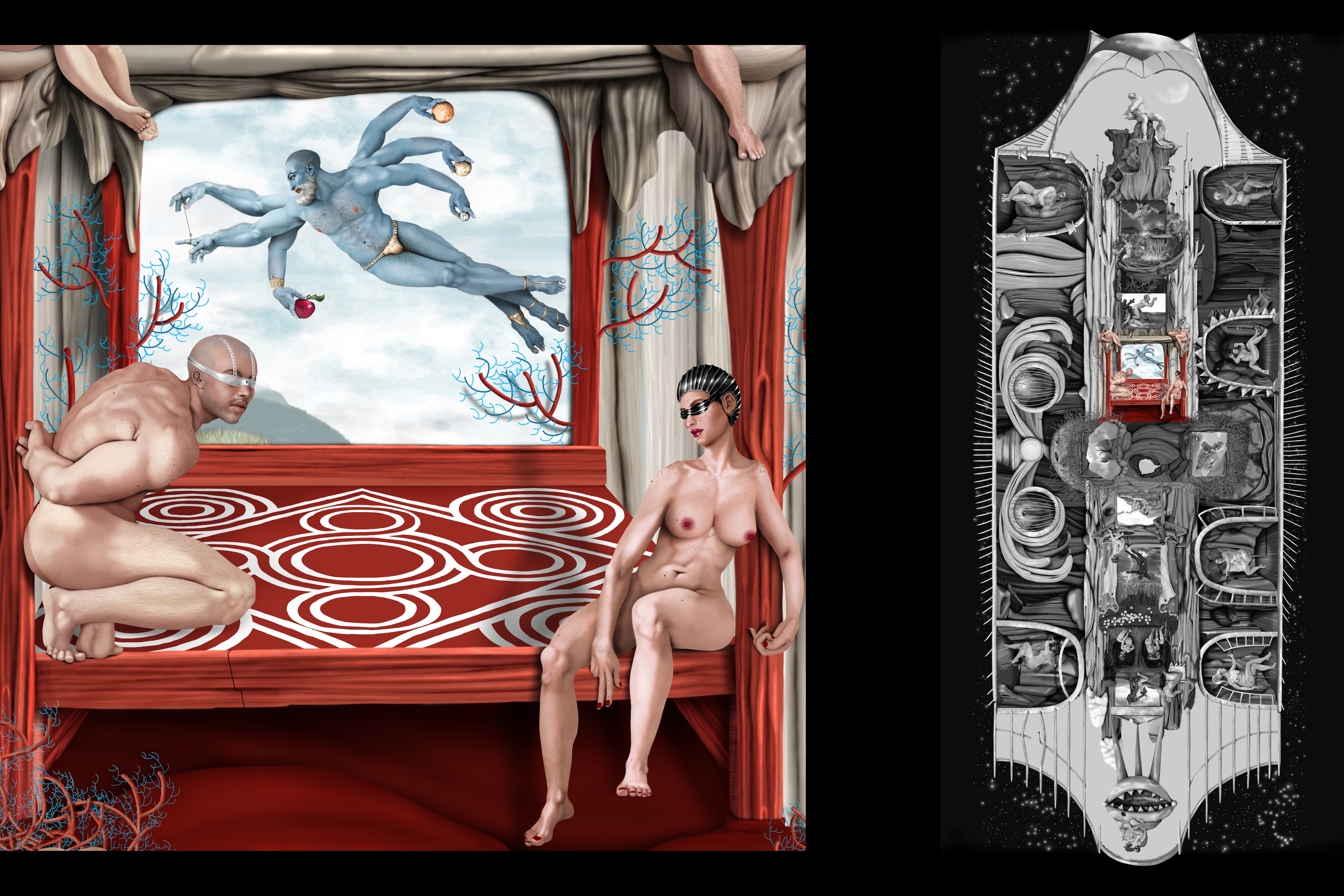
THE ARTWORK
Michelangelo’s Sistine Chapel was a religious yet social synthesis of his time.
In my SZ Chapel I’d like to keep the synthetic aspect but purged from religion and no longer based on biblical stories.
SZ Chapel is about human beings, their strengths and their weaknesses.
The first of the six main scenes depicting Adam talks about a man fought and dragged between two natures: animal (dog) and divine (God).
In the second one Eve gives birth to Adam’s sons who feels with his hands bound.
The Original Sin shows a seducing Eve in a plastic pose while Adam is trying to resist.
It is also implicit the natural sensual/sexual relationship between the two.
The God’s trilogy is based on the modern physics.
The three Gods represent the three fundamental interactions:
- Gravity
- Electromagnetic
- Atomic
Each of them is described mathematically as a field and everything in nature moves following one of these forces.
So, from the inner “forces” moving the human behaviour and thoughts (Adam and Eve) to the forces regulating the nature (God’s trilogy).
The SZ Chapel’s structure is comparable to Plato’s Allegory of the Cave*.
The Ignudi (athletic figures surrounding the main scenes) are blindfolded.
They are part of the main scenes but they are not able to participate nor understand what’s happening there (fig. 7).
Fig. 7

Supernatural beings are on the border of the artwork.
They are the antithesis of the Ignudi even if some of them are blind too.
I’m talking about Sibille and Prophets (fig. 8-12), who are handling and respecting the four elements (fire, water, earth and air) and the natural laws.
For example figure 8 shows prophet Isaiah in his cave.
On the golden frame of the cave there are symbols of earth, air, fire and water.
Prophets and Sibille’s words are beyond the human understanding as well as their skin colors and shapes in SZ Chapel.
They live alone, misunderstood but enlightened in caves that remind of the brain’s anatomy; dark and fleshy.
Fig. 8
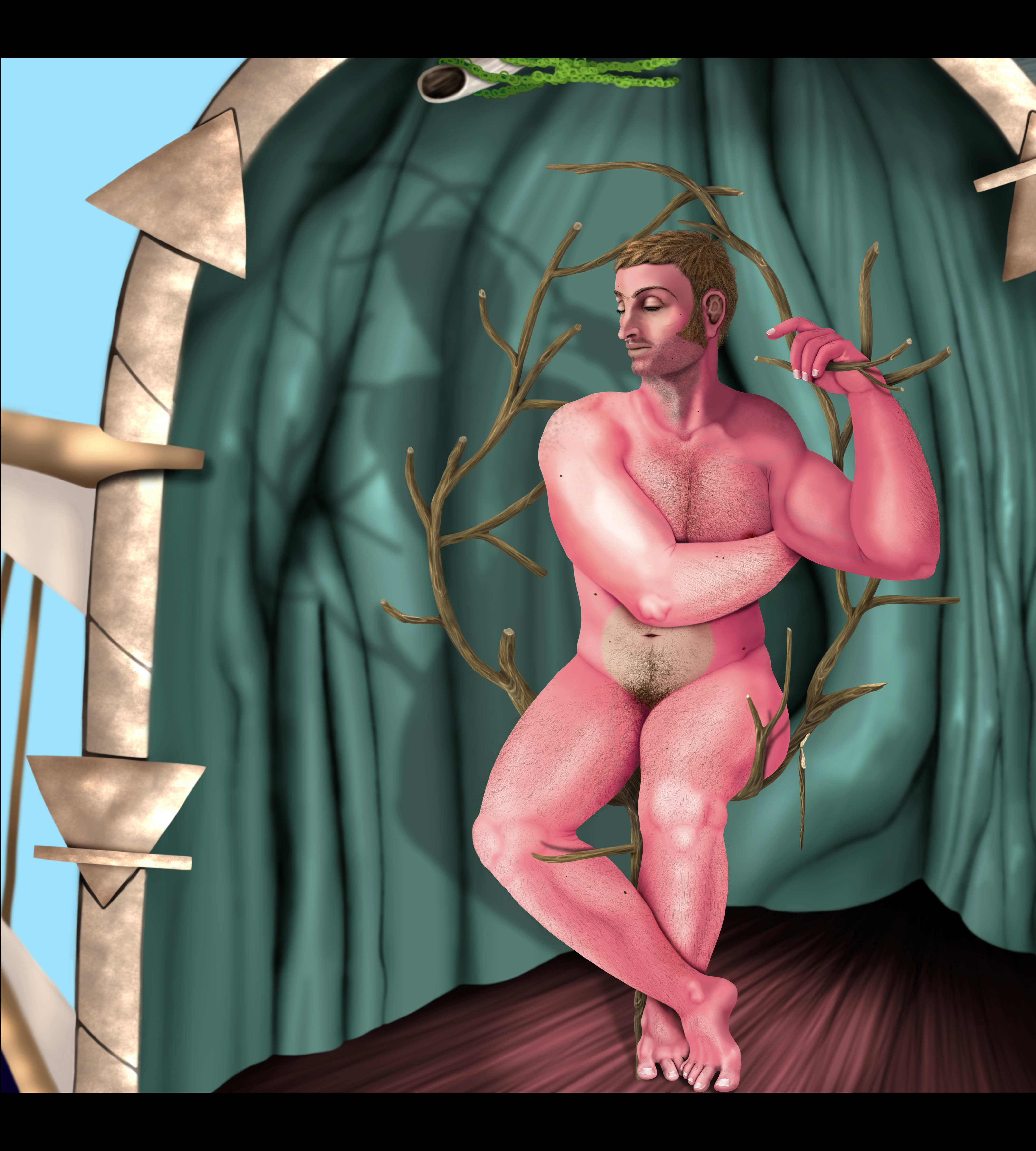
Fig. 9

Fig. 10

Fig. 11

Fig. 12

The sky surrounding the whole composition is divided into seasons represented by the zodiac’s constellations:
- Spring with Aries, Taurus and Gemini
- Summer with Cancer, Lio and Virgo
- Autumn with Libra, Scorpio and Sagittarius
- Winter with Capricorn, Aquarius and Pisces
In the very center of the artwork there are two selfportraits (fig. 13-14).
The first depicts the artist leaving the artwork, the second one shows the artist judging the scene from a privileged point of view.
They are metaphors of the man always seeking new worlds and challenges but also of the man who knows where he comes from even if he’s not forced to accept it fully.
It is also metaphor of a God who is not out but inside each of us.
Fig. 13

Fig. 14

Fig. 15

Fig. 16

Fig. 17

*Plato has Socrates describe a group of people who have lived chained to the wall of a cave all of their lives, facing a blank wall. The people watch shadows projected on the wall from objects passing in front of a fire behind them, and give names to these shadows. The shadows are the prisoners’ reality. Socrates explains how the philosopher is like a prisoner who is freed from the cave and comes to understand that the shadows on the wall are not reality at all, for he can perceive the true form of reality rather than the manufactured reality that is the shadows seen by the prisoners. The inmates of this place do not even desire to leave their prison; for they know no better life. The prisoners manage to break their bonds one day, and discover that their reality was not what they thought it was. They discovered the sun, which Plato uses as an analogy for the fire that man cannot see behind. Like the fire that cast light on the walls of the cave, the human condition is forever bound to the impressions that are received through the senses. Even if these interpretations are an absurd misrepresentation of reality, we cannot somehow break free from the bonds of our human condition – we cannot free ourselves from phenomenal state just as the prisoners could not free themselves from their chains. If, however, we were to miraculously escape our bondage, we would find a world that we could not understand – the sun is incomprehensible for someone who has never seen it. In other words, we would encounter another “realm”, a place incomprehensible because, theoretically, it is the source of a higher reality than the one we have always known; it is the realm of pure Form, pure fact.
ABOUT SZ CHAPEL
Reinventing a work of art that millions of people around the world are emotionally committed to, whether through an appreciation of classic art or through devout religious beliefs, takes, to put it bluntly, enormous balls. Yet this audacity is the driving force behind works of art that tries to decipher human nature and define popular culture.
The 38-year-old Swiss artist has been producing digital works of art that both critiques and elevates modern myths. Pop culture archetypes, from Paris Hilton to Anna Wintour, are depicted not as people but for the status and value that these celebrities are given by the culture at large and what exactly that says about us.
Utilizing a new digital fresco technique, Zanolari is now tackling one of the world’s most iconic works of art, The Sistine Chapel Frescoes by Michelangelo. By basing his latest project on such a ubiquitous work, Zanolari seems to be updating a 3500 year old fairy tale (the content) as well as redefining our relationship to a 500 year old idol (the artwork itself).
Approximately five million people visit the Sistine Chapel every year, drawing in an estimated revenue of 80 million euro to the Vatican. It can be argued that the main draws to the chapel are Michelangelo’s two frescoes, commissioned in 1508 by Pope Julius II and executed between 1508 and 1512. The frescoes are comprised of the ceiling, a large scale project which terrified the artist, then most known for his sculptures, and the Last Judgment, which spans the wall behind the alter of the Sistine Chapel. Controversial for its depiction of nudity, The Last Judgment spawned the “Fig leaf Campaign” and artist Daniele da Volterra later covered the offending genitalia.
Zanolari starts by deconstructing da Volterra’s grafitti and depicts his “existentialist description of man, his nature and the context where he lives.” with anatomically correct figures, inverted sexes, and hybrids of man and animal. By reproducing the original accurately but simply changing the details, Zanolari purges the original story of all the institutional and religious aspects and long held dogma attached to the work. And by presenting it to an audience who have held the wonders of technology and the experiences of media, plastic surgery, and science, the story unfolds in a way that is perhaps more relatable than the original.
Saul Zanolari has enormous balls.
-Roger Padilha, author of GLOSS: The Work of Chris von Wangenheim, Antonio Lopez, and The Stephen Sprouse Books-
From SZ Chapel book, published by JOYCE Hong Kong in occasion of the double show
SZ Chapel Beijing/Shanghai (2014)
It has been more than one year that Saul Zanolari has been working on a new vision of the Sistine Chapel using Michelangelo as inspiration.
A work which intricately focuses on every minute detail even those which many would describe as insignificant.
Joyce HK is presenting the currently half-completed work in their two galleries in Beijing and Shanghai as well as in a book.
Whilst the characters which feature in Zanolari’s work are those featured in that of Michelangelo’s, Saul has radically changed their function and concept.
He has created a brand new masterpiece which is not simply an imitation.
The artist depicts in his half-completed work six main scenes from the ceiling representing the Creation according to the Old Testament (the story of Adam, Eve, the Original Sin etc…), ten Ignudi and three Sybils.
“Ignudi” are human beings, naked, which are supporting and observing the main picture.
“Sybils” are mythological creatures with the ability to divine the future.
So, who is the main protagonist of this new artwork?
Irony.
This unique irony is cleverly mixed with the main themes of life such as spirituality, travel, freedom, etc…
The artist takes the serious nature of Michelangelo’s work and converts it into an almost childlike cartoon aesthetic.
Nudity associated with spirituality has never been accepted, not in the 1500s nor in 2014.
In fact, nothing has changed given that Saul, just like Michelangelo, has had to cover the nudity of his characters.
To respond to this, the artist has created 2D clothes seen and worn by us on a daily basis.
“Uniforms” that form part of the common and easily recognisable imagery of the world.
This underlines that, although depicted as “divine beings”, these characters that Saul has removed from the ceiling, are in fact US.
They are the common people that you and I cross in the street, the audience of the show, the readers of the book.
Just like the characters of the Sistine Chapel, we live our lives admiring the work and drawings of something ‘greater than us’ even though we actually form a great part of it.
We are fragile and we are separated from our nudity by a veil.
Nudity is not just physical.
The veil is a uniform that we can easily change and remove.
Press release of SZ Chapel, Kir Royal Gallery (Valencia)
Saul Zanolari was born in 1977 in Mendrisio, Switzerland.
Since when he was a child he was interested in art and its forms of expression; especially painting.
In 2005 his interest moved from traditional to digital painting. He started to exhibit in several international galleries with artworks depicting reinvented celebrities and pop stars; investigating and exaggerating some of their typical features.
In his first solo exhibition in Spain, Kir Royal Gallery presents some of his portraits of famous people and models.
There will also be a selected works from his 2012-15 project; the remake of Michelagelo’s Sistine Chapel. Scenes and characters of Michelangelo’s masterpiece are recreated via a digital fresco technique keeping to the original scale but utilising Zanolari’s unique style.
In the digital fresco we can recognize some of the central stories.
We see the Creation of Adam, depicting the famous fingers touch between Adam and God and symbolising the transmission of the breath of life.
We also see the Creation of Eve where the figures of Adam and Eve are inverted from the original image and the Original Sin with a black Adam wearing only a golden thong; and the Flood replaced by a modern siren.
Saul preserved Michelangelo’s Sistine Chapel composition and many other original features like the muscled female’s bodies (despite Michelangelo’s models being men) and the naked bodies, which Michelangelo had introduced in the pre-censorship original version.
Saul’s version of the great artwork is rather ironic with a slice of humorous malice.
He depicts the Ignudi, are blindfolded with black masks as in an erotic game. Sibyls and Prophets are depicted with a strong voluptuous and sensual charge.
Beside these, the artist adds a personal mythology, his own Olympus including the Nuclear God, with the atom symbol in gloves and slip; the Magnetism God, throwing his rays in the sky; and the Gravity God, blue and six arms like the Hindu God Shiva, but with the planets in his hands and an apple, Newton’s apple or perhaps Eve’s.
Finally, in the centre of the composition, as a supreme God, the artist portrays himself, Creator of his World and his Work. A self-portrait in which he points the finger at the viewer as if the viewer were subjected to his judgment and not the contrary as it should be. A game of glances and perspectives, such as the ones of the portrayed subjects, a product of the artist’s imagination; which includes every little detail, down to the reflection in each eye.
“SZ Chapel” de Saul Zanolari
C / Reina Doña Germana, 24
-María Ramis on MAKMA, Revista de Arte Visuales y Cultura Contemporanea-